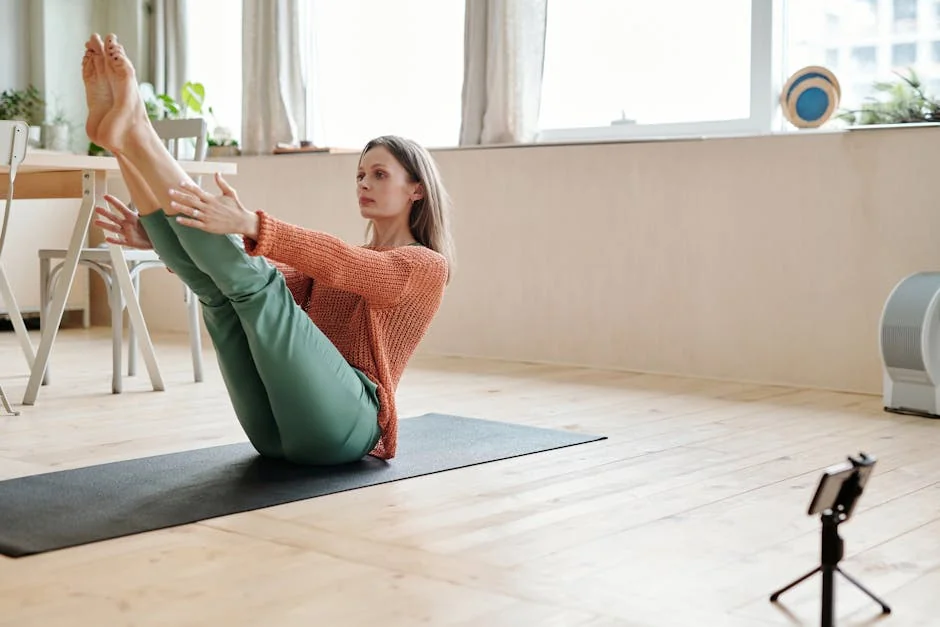Does your quest for inner peace constantly get derailed by a screaming knee or an aching back? You're not alone. The single biggest hurdle for many new and experienced meditators isn't a wandering mind—it's a wandering focus caused by physical discomfort. The truth is, finding your perfect comfortable meditation position is not a luxury; it's the essential foundation upon which a sustainable and deep practice is built. Forget the intimidating images of contorted lotus poses. True comfort in meditation is about achieving a posture that is both alert and relaxed, allowing you to let go of physical distractions and turn inward. This guide is your roadmap to that place of ease. We'll walk you through the core principles of supportive posture and introduce you to a variety of positions, from using a simple chair to finding your seat on a cushion, so you can finally sit without pain and meditate with focus.
Why Your Comfortable Meditation Position is the Foundation of Practice
Think of your physical posture as the launchpad for your mental journey. If the launchpad is unstable, uneven, or causes constant alarms to go off, your rocket—your focus—isn't going anywhere. A comfortable meditation position serves three critical functions that directly impact the quality of your practice.
First, it minimizes physical distraction. When your leg is falling asleep or your lower back is screaming for relief, your attention is forcibly pulled away from your breath or mantra and into the sensation of pain. The goal of meditation isn't to endure discomfort, but to observe the mind. A supportive posture allows you to settle in and forget your body for a while, creating the mental space needed for observation.
Second, a stable physical position promotes mental stability. There's a profound connection between the body and the mind. A slumped, collapsed posture can lead to a sluggish, drowsy mind. Conversely, a tense, rigid posture can create mental agitation. Finding the middle way—a spine that is upright yet natural—facilitates a state of alert calmness, making it easier to stay present and aware.
Finally, comfort directly influences the duration and consistency of your practice. If you dread sitting down because you know it will be painful, you're less likely to do it. A position that feels sustainable and kind to your body encourages you to meditate more often and for longer periods, deepening your practice over time. For example, committing to a consistent practice like twenty minutes meditation becomes much more achievable when you are physically at ease.
The Core Principles of a Supported and Comfortable Posture
Before we explore specific positions, let's establish the universal principles of good meditation posture. These are the building blocks you will apply whether you're in a chair, on a cushion, or on a bench. Aim for these qualities, but remember: the goal is "alert and relaxed," not perfect.
A Straight, Not Rigid, Spine: This is the most important principle. Imagine your vertebrae stacking gently one on top of the other. The natural curves of your spine (in the neck and lower back) should be present but not exaggerated. This alignment allows for effortless breathing and helps maintain alertness. You are not a soldier at attention; you are a majestic mountain—stable and dignified.
Relaxed Shoulders & Open Chest: Gently roll your shoulders up toward your ears, then back and down. This opens up the chest and prevents the hunching that leads to shallow breathing. Your hands should rest comfortably on your knees or in your lap, with the elbows falling naturally.
A Slight Tuck of the Chin: Imagine a string pulling the crown of your head gently toward the ceiling. This creates a slight tuck in the chin, which lengthens the back of your neck. Your gaze will naturally fall softly a few feet in front of you. Avoid jutting your chin forward or dropping your head completely.
Hands Resting Comfortably: Your hands can rest in a number of ways. A common mudra (hand position) is to place the right hand in the left, with thumbs gently touching, forming an oval. This is known as the cosmic mudra. Alternatively, you can simply rest your palms face down on your knees to promote grounding, or face up on your knees to cultivate receptivity.
5 Comfortable Meditation Positions to Try Today
Now, let's apply these principles to practical, accessible positions. Start with the one that feels most natural to your body today, and remember that your ideal position can change from day to day.
Meditating in a Chair: Accessible and Supportive
This is arguably the most accessible and often the most overlooked comfortable meditation position. It is perfect for beginners, anyone with mobility limitations, or those dealing with knee or ankle injuries.
- Choose the Right Chair: Use a sturdy, straight-backed chair. Avoid soft, sinking armchairs.
- Sit Forward: Do not lean against the chair's back. Sit on the forward half of the seat. This encourages you to use your own core muscles to support your spine, rather than slouching into the chair.
- Feet Flat on the Floor: Place your feet flat on the ground, hip-width apart, with your knees directly above your ankles. If your feet don't reach the floor, use a cushion, folded blanket, or books under your feet.
- Check Your Posture: Follow the core principles. Stack your spine, relax your shoulders, and tuck your chin. Your hands can rest on your knees or in your lap.
The Seated Meditation Cushion: Finding Your Base
Sitting on the floor elevates your hips, which naturally helps to tilt the pelvis forward and maintain the natural curve of your lower back. This is the classic image of seated meditation.
- The Cushions: A meditation cushion (or zafu) is a firm, round cushion filled with buckwheat hulls or kapok. It provides lift. A mat (zabuton) placed underneath provides cushioning for your ankles and knees.
- The Burmese Position: This is the simplest and most accessible cross-legged pose. Both feet rest flat on the floor, with one ankle in front of the other. It doesn't require the hip flexibility of the lotus poses and is stable and comfortable for many people.
- Achieving the Half-Lotus Pose: A more stable pose than simple cross-legged. One foot rests on the opposite thigh, while the other foot rests on the floor beneath the opposite knee. It's important to alternate which leg is on top to maintain balance in the hips. Only attempt this if it is pain-free for your knees.
Kneeling with a Meditation Bench: Relief for Your Knees
If cross-legged positions are uncomfortable, a kneeling posture using a meditation bench can be a game-changer. It takes all the strain out of your hips and ankles.
- How It Works: You kneel on a soft mat (a zabuton or folded blanket) and place the bench over your calves. You then sit back on the bench, which supports your entire body weight.
- Benefits: This position automatically creates a very stable, upright spine with a natural pelvic tilt. It's excellent for those with tight hips but relatively healthy knees.
- Pro-Tip: You can adjust the height by placing folded blankets on top of the bench. Ensure there is no sharp pinching in your knees.
Lying Down Meditation: For Restorative Practice
The Savasana, or Corpse Pose, is a valid and powerful comfortable meditation position, particularly for body scan meditations or when you are ill, exhausted, or dealing with pain that makes sitting upright impossible.
- The Setup: Lie flat on your back on a mat or carpet. Let your feet fall out to the sides, and place your arms a few inches away from your body with palms facing up.
- The Pros and Cons: The great benefit is total physical relaxation. The primary challenge is the high likelihood of falling asleep. To stay alert, you can try keeping your knees bent with feet flat on the floor, or place a thin pillow under your head.
- Using Props: If you have lower back discomfort, place a cushion or rolled blanket under your knees. This relieves pressure on the lumbar spine.
Troubleshooting Common Discomforts
Even in a good position, small discomforts can arise. Here’s how to address them without breaking your meditation.
- Aching Knees or Ankles: This is a sign that your joints are under strain. Immediately come out of any cross-legged pose that causes knee pain. Switch to a chair, a kneeling bench, or try the Burmese position with more cushioning under your ankles.
- Lower Back Pain: This often indicates a slumped posture or tight hips. For chair-sitters, ensure you are sitting forward and not leaning back. For cushion-sitters, try elevating your hips higher by sitting on a thicker cushion or folded blankets. This helps tilt the pelvis forward.
- Falling Asleep: If drowsiness is a constant battle, check your posture. A slumped spine can induce sleep. Straighten your back, open your chest, and try meditating with your eyes slightly open, with a soft, downward gaze. Meditating at a different time of day, when you are more alert, can also help. A practice like the best day ever meditation is often best done in the morning when energy levels are high.
- Restlessness: It's normal to feel an urge to move. Before you move, simply observe the sensation with curiosity. Is it a true pain signal, or just mental agitation? If it's pain, adjust your posture mindfully. If it's restlessness, see if you can breathe through it for a few more moments. For some, a dynamic practice like walking meditation can be a perfect alternative when seated restlessness is too strong.
How to Choose the Best Position for Your Body
The "best" comfortable meditation position is the one that works for you, today. Let your body be your guide.
- Listen to Pain vs. Discomfort: Learn the difference. A dull ache from using new muscles is discomfort; it often fades as you get stronger. A sharp, shooting, or pinching pain in a joint is a signal to stop and adjust.
- Experiment: Your needs may change. One day you might feel open and stable in a cross-legged pose; another day, the chair might be your sanctuary. Give yourself permission to use different props and positions.
- Focus on the Foundation: Regardless of the pose you choose, always return to the core principles: a stable, upright spine, relaxed shoulders, and a sense of dignified ease. The form serves the function of a calm and focused mind. Once you're comfortable, you can begin to explore different goals, such as using meditation to clear your mind of mental clutter.
Your meditation practice is a personal journey of kindness and awareness, and that journey begins with how you treat your body. By investing time in finding your unique comfortable meditation position, you remove the biggest barrier to a consistent practice. You are building a foundation of physical ease that allows your mind to explore, rest, and awaken. So, let go of the ideal, listen to the wisdom of your body, and take your seat with confidence.
Ultimately, the most comfortable meditation position is the one that allows you to practice consistently. Whether seated in a chair, cross-legged on a cushion, or even lying down, physical stability is the foundation for mental clarity. The key is to prioritize an alert yet relaxed posture where your spine can be naturally upright and your body supported, freeing your mind from the distraction of discomfort. Remember that perfection is not the goal; adaptability is. Your practice will evolve, and so too might your preferred position as you learn to listen to your body’s needs. Let this flexibility empower you, removing the barrier of imagined rules. The true essence of meditation unfolds not from a perfect form, but from the simple, dedicated act of returning to the present moment. Start where you are, use the supports you need, and trust that your commitment is far more important than any specific pose. Your journey inward begins with a single, comfortable breath.



